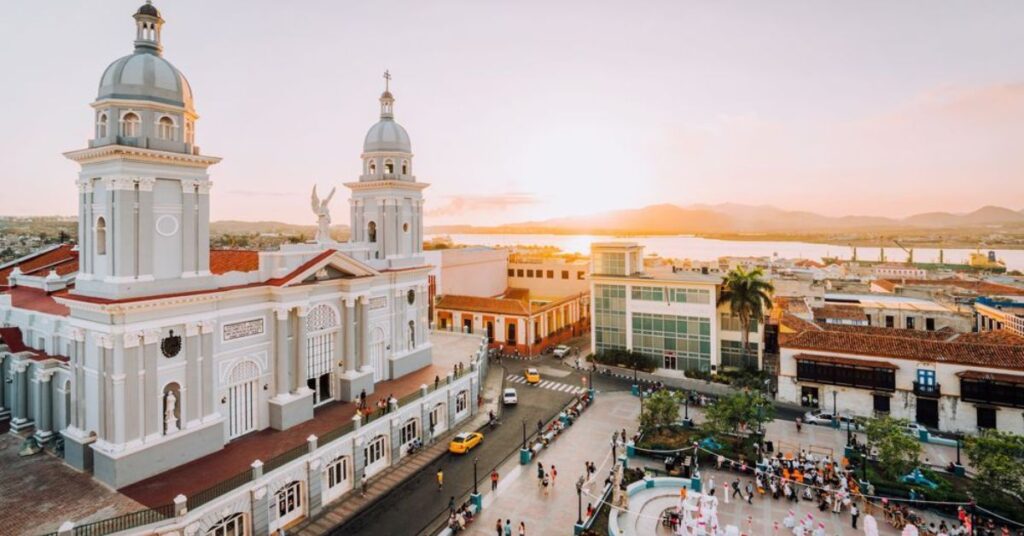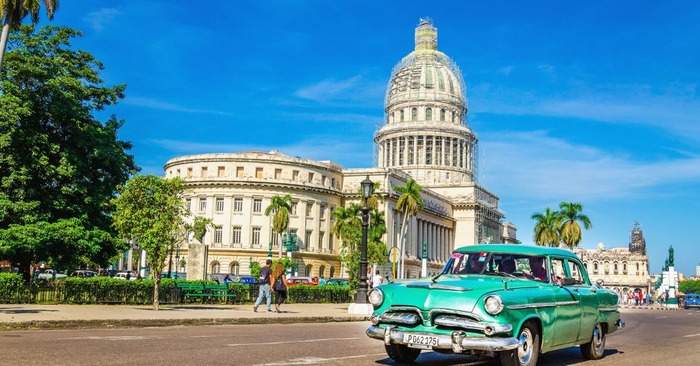Cuba is a land of vibrant culture, rich history, and stunning landscapes. The country offers travelers an unforgettable experience through its diverse cities. Whether you’re exploring the colorful streets of Havana or soaking in the colonial charm of Trinidad, each city has its own unique appeal.
Each city in Cuba tells a different story. From the revolutionary energy of Santiago de Cuba to the tranquil parks of Holguín, there’s something for everyone. Discover architectural wonders, lively music scenes, and welcoming locals in every corner of the island. These cities are not just places to visit; they are destinations that invite you to experience the true essence of Cuba.
As we go on this journey through Cuba’s most captivating urban landscapes, get ready to discover hidden gems, immerse yourself in centuries of history, and indulge in the flavors of authentic Cuban cuisine.
Also, read this blog:https://bagispack.com/16-things-to-know-before-visiting-the-usa/
Discover the Charm of Havana: Cuba’s Capital City
Havana, Cuba’s vibrant capital, is frozen in time yet pulsing with energy. Vintage cars cruise past colorful colonial buildings, while the sounds of live music spill from every corner. The city’s rich history is evident in its architecture, from the iconic Malecón seawall to the majestic Capitolio.
Explore Old Havana, a UNESCO World Heritage Site, with its narrow streets and lively plazas. Don’t miss the chance to sip authentic Cuban rum, visit the famous Colon Cemetery, or dance the night away in one of the city’s many salsa clubs. Havana’s charm lies in its ability to surprise and delight at every turn.
Why Trinidad is a Must-Visit for History Lovers
Trinidad, a perfectly preserved Spanish colonial settlement, is a history lover’s paradise. Founded in 1514, the city’s cobblestone streets and pastel-colored houses transport visitors back in time. The Plaza Mayor, surrounded by grand colonial buildings, serves as the heart of this enchanting town.
Explore the Museo Histórico Municipal, housed in a mansion once owned by sugar barons, to delve into Trinidad’s past. The opportunity to climb the bell tower of the Convento de San Francisco for panoramic views of the city and the surrounding Valle de los Ingenios, a UNESCO World Heritage Site.
Explore Santiago de Cuba: The Birthplace of the Cuban Revolution

Santiago de Cuba, the country’s second-largest city, is known for its revolutionary history and vibrant Afro-Cuban culture. As the birthplace of the Cuban Revolution, it’s home to numerous historical sites, including the Moncada Barracks and the Santa Ifigenia Cemetery, where national hero José Martí is buried.
The city’s lively music scene is unparalleled, with son and rumba rhythms filling the air. Visit during July to experience the Carnaval de Santiago, Cuba’s largest and most exuberant carnival celebration.
Cienfuegos: The Pearl of the South
Cienfuegos, known as the “Pearl of the South,” stands out with its French-influenced architecture and stunning bay location. Founded in 1819, it’s one of Cuba’s youngest cities, yet its historic center is a UNESCO World Heritage Site. The wide boulevards and elegant buildings give Cienfuegos a distinct European flair.
Stroll along the Malecón, visit the Thomas Terry Theater, and explore Punta Gorda, a peninsula with beautiful mansions. The Palacio de Valle is an architectural masterpiece blending Gothic, Romanesque, and Moorish styles. Cienfuegos offers a perfect blend of history, culture, and natural beauty.
Also, read this blog:https://bagispack.com/tips-for-all-first-timers-traveling-to-mexico-city/
Why Camagüey’s Maze-Like Streets Will Fascinate You
Camagüey, Cuba’s third-largest city, is famous for its labyrinthine street layout, which was designed to confuse pirates in colonial times. This unique urban plan, along with its well-preserved historical center, has earned it UNESCO World Heritage status. The city is known for its numerous churches and vibrant art scene.
Explore the narrow alleys, discover hidden plazas, and admire the colorful tinajones (large clay pots) that adorn many courtyards. Visit the Iglesia de Nuestra Señora de la Merced and climb its tower for panoramic views. Camagüey’s charm lies in its ability to surprise visitors around every corner.
Holguín: The City of Parks
Holguín, often called the “City of Parks,” offers a more laid-back Cuban experience. Known for its numerous leafy squares, the city provides a perfect blend of urban amenities and natural beauty. Holguín is also the gateway to some of Cuba’s most stunning beaches, including Guardalavaca and Playa Esmeralda.
Climb the Hill of the Cross for panoramic views of the city, explore the Calixto García Park, and visit the La Periquera museum to learn about local history. Give yourself the chance to experience the Romerías de Mayo, a vibrant cultural festival held annually in May.
Matanzas: The Venice of Cuba

Matanzas nicknamed the “Venice of Cuba” due to its many bridges spanning three rivers, is a city rich in culture and history. Known as the birthplace of danzón and the Afro-Cuban religion of Santería, Matanzas offers a unique glimpse into Cuba’s diverse cultural heritage.
The Pharmaceutical Museum, visit the San Severino Castle and stroll along the Paseo del Prado. Nature lovers shouldn’t miss the nearby Varadero beach or the stunning Bellamar. Caves. Matanzas’ blend of urban charm and natural beauty makes it a must-visit destination in Cuba.
Immerse yourself in the vibrant culture of Havana.
Havana’s cultural scene is unparalleled, offering a rich tapestry of experiences. Visit the Fábrica de Arte Cubano, a unique cultural complex that combines art, music, and dance. Explore the Museo Nacional de Bellas Artes to admire Cuban and international art spanning several centuries.
Attend a performance at the Gran Teatro de La Habana, home to the National Ballet of Cuba. For literary enthusiasts, visit Ernest Hemingway’s former home, Finca Vigía. Give yourself the chance to experience Havana’s vibrant nightlife, from jazz clubs to salsa venues.
Top Attractions to Visit in Santiago de Cuba

Santiago de Cuba offers a wealth of attractions beyond its revolutionary history. Visit the Castillo de San Pedro de la Roca, a 17th-century fortress and UNESCO World Heritage Site. Explore the Basílica de Nuestra Señora del Cobre, Cuba’s most important pilgrimage site.
For nature lovers, the nearby Gran Parque Nacional Sierra Maestra offers hiking opportunities and stunning views. Music enthusiasts should visit Casa de la Trova, a legendary venue for traditional Cuban music.
The Best Colonial Architecture in Trinidad
Trinidad’s colonial architecture is a testament to its rich history. The Palacio Brunet, now housing the Museo Romántico, showcases the opulence of 19th-century sugar barons. Visit the Iglesia y Convento de San Francisco to admire its distinctive yellow bell tower and panoramic views.
Explore the Casa de los Conspiradores, a key site in Cuba’s independence movement. The Palacio Cantero, now the Municipal History Museum, offers insights into Trinidad’s past. The opportunity to wander the cobblestone streets and admire the colorful facades of well-preserved colonial homes.
Why Cienfuegos is Perfect for a Relaxing Getaway
Cienfuegos offers a more relaxed pace compared to other Cuban cities, making it ideal for a laid-back vacation. Spend time at Rancho Luna Beach, just a short drive from the city center. Visit the Jardín Botánico de Cienfuegos, one of Cuba’s largest botanical gardens, to enjoy its diverse plant collection.
Take a boat trip on the bay to explore Castillo de Jagua, an 18th-century fortress. For a unique experience, visit the Delfinario for a dolphin show or even swim with these intelligent creatures. Cienfuegos’ combination of cultural attractions and natural beauty provides the perfect setting for a rejuvenating getaway.
Camagüey’s Unique Art and Culture Scene

Camagüey boasts a thriving arts scene, with numerous galleries and studios dotting its winding streets. Visit the Casa de Arte Jover, showcasing works by local artists. Explore the Martha Jiménez Pérez studio and gallery, known for its unique sculptures and ceramics.
The Museo Provincial Ignacio Agramonte, housed in a former cavalry barracks, offers insights into the city’s history and culture. For a theatrical experience, attend a performance at the Principal Theater. Camagüey’s artistic spirit is evident in its street art, colorful buildings, and vibrant cultural events.
Holguín’s Hidden Gems: What to See and Do
Beyond its parks, Holguín offers several hidden gems worth exploring. Visit the Museo de Historia Provincial “La Periquera” to learn about local history. The Loma de la Cruz is a hill with a large cross offering panoramic views of the city and surrounding countryside.
For a unique experience, visit Bariay National Monument Park, where Christopher Columbus first landed in Cuba. Nature lovers should explore the nearby Bahía de Naranjo Nature Park, home to diverse wildlife.
Experience the natural beauty of Matanzas.
Matanzas Province is home to some of Cuba’s most stunning natural attractions. Visit the Varadero Peninsula, known for its pristine beaches and crystal-clear waters. The Yumur Valley is a lush landscape dotted with sugar cane fields and picturesque villages.
For bird-watching enthusiasts, the Ciénaga de Zapata National Park offers opportunities to spot rare species. Matanzas’ diverse natural landscapes provide endless opportunities for outdoor adventures and relaxation.
Cuban Cuisine: Where to Eat in Each Must-See City
Cuban cuisine is a delightful fusion of Spanish, African, and Caribbean influences. In Havana, try La Guarida, a famous paladar (private restaurant) known for its innovative takes on Cuban classics. In Trinidad, visit Sol Ananda for a unique dining experience in a colonial mansion.
Santiago de Cuba offers excellent seafood; try El Morro restaurant for stunning views and fresh catches. In Cienfuegos, don’t miss Paladar Aché for authentic Cuban home cooking. Camagüey’s Restaurante 1800 offers gourmet Cuban cuisine in a historic setting.
The Best Time to Visit These Must-See Cities in Cuba
The best time to visit Cuba is generally from December to May, during the dry season. This period offers pleasant temperatures and lower humidity, making it ideal for exploring cities and beaches.
Havana is lively all year, but the Havana Jazz Festival in January is a highlight. Trinidad is beautiful year-round but can get crowded during peak tourist season (December–April). Santiago de Cuba comes alive during the Carnaval in July.
How to Travel Between Cuba’s Must-See Cities

Traveling between Cuba’s cities can be an adventure in itself. The most reliable option is Viazul, Cuba’s main bus company for tourists. They offer comfortable, air-conditioned buses connecting major cities. Reservations are recommended, especially during peak season.
For a more local experience, try the Conectando Cuba shared taxi service. These are often classic American cars that run set routes between cities. While less comfortable than buses, they’re faster and offer a uniquely Cuban travel experience.
Insider Tips for Exploring Cuba’s Must-See Cities
When exploring Cuba’s cities, embrace the local way of life. Use CUP (Cuban Pesos) when possible, as it’s often cheaper than paying in CUC (Cuban Convertible Pesos). Learn some basic Spanish phrases; locals appreciate the effort, and it can enhance your experience.
Stay in casas particulares (private homestays) for an authentic Cuban experience and insights from local hosts. For limited internet access, download offline maps and guides before your trip. Carry cash, as credit cards are not widely accepted.
FAQ’s
Which city is safe in Cuba?
Havana is generally safe, especially in tourist areas, but like any major city, it’s important to stay aware of your surroundings and avoid less-populated areas at night.
What are the three most important cities in Cuba?
The three most important cities in Cuba are Havana (the capital), Santiago de Cuba (historical and cultural significance), and Trinidad (a UNESCO World Heritage Site).
What is the best city to live in Cuba?
Havana is often considered the best city to live in Cuba due to its vibrant culture, access to amenities, and economic opportunities.
How can we stay safe in Cuba?
Stay safe in Cuba by avoiding isolated areas at night, keeping valuables secure, using official taxis, and being cautious of scams targeting tourists.
Is Cuba one of the safest countries?
Yes, Cuba is considered one of the safest countries in Latin America, with low violent crime rates, especially for tourists.
Conclusion
Cuba’s cities offer a unique blend of history, culture, and natural beauty, making them a captivating destination for travelers. From the vibrant streets of Havana to the colonial charm of Trinidad, each city has its own distinct personality and attractions.
Exploring revolutionary landmarks in Santiago de Cuba, relaxing in the serene atmosphere of Cienfuegos, or discovering the hidden gems of Holguín, Cuba, promises an unforgettable experience. With its rich cultural heritage, warm hospitality, and safe environment, Cuba is a must-visit destination that will leave you with memories to cherish for a lifetime.

BagisPack.com: Your ultimate travel companion. Explore expert travel tips, packing guides, and destination insights. Empowering adventurers with essential advice for seamless journeys around the globe.








